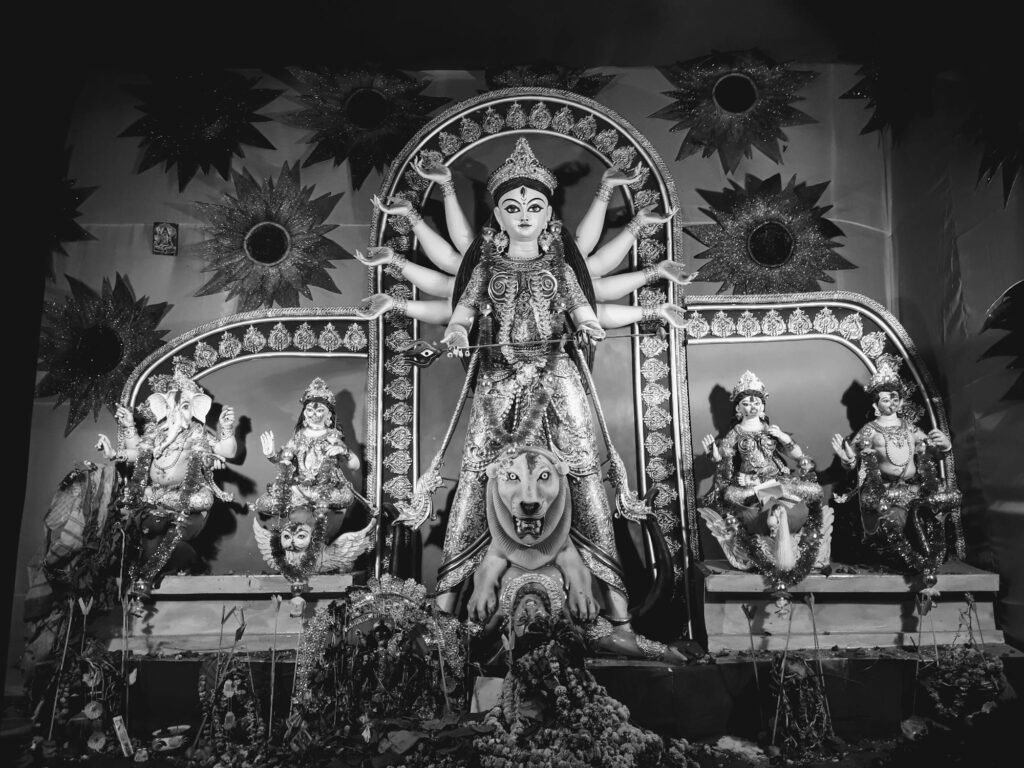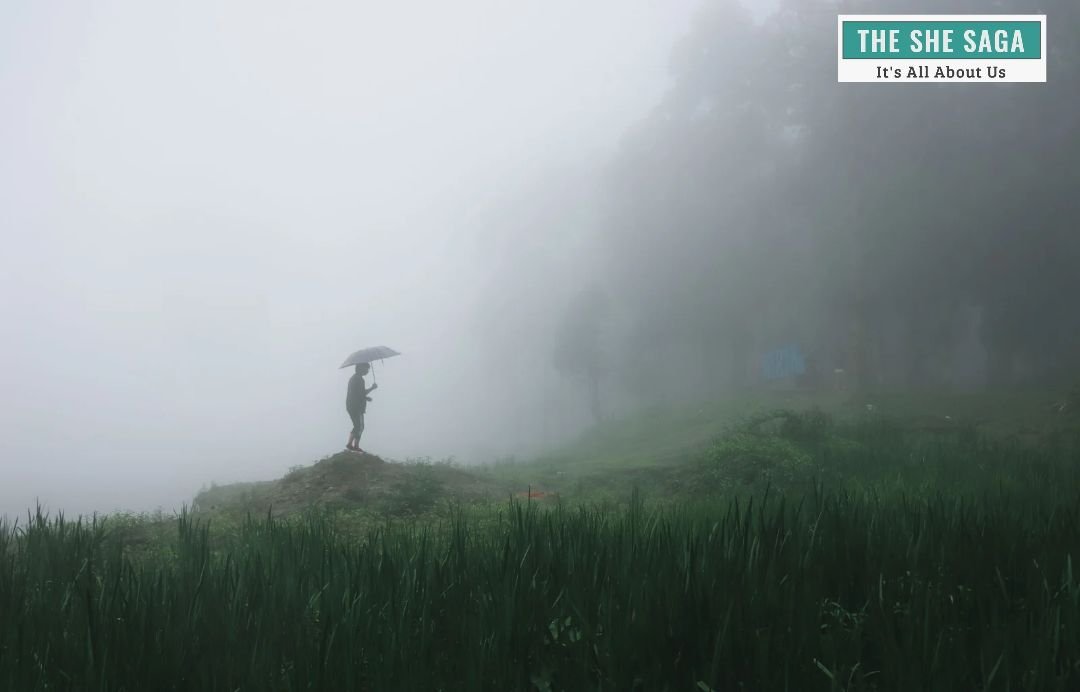Being a Kolkata Tamilian, I’ve embraced the best of Navratri and Sharadiya. The countdown has begun, and I cannot wait for October to kick in. In the autumnal breeze, the kash flowers sway gently. I am not in the mood to indulge in an extravagant display of bhakti and fashion, as grieving parents seek justice for their beloved Abhaya. But, as is my wont, I take a trip down memory lane.
I find myself in the Calcutta of the 1980s.
That Unforgettable Voice
The old grandfather clock at 109/5A Hazra Road strikes four. A seven-year-old girl turns and tosses in her bed. Her grandmother nudges her.
“It’s Mahalaya today.”

The girl, groggy-eyed, wakes up mumbling. She walks to the sink and splashes her face with cold water. By then, her grandfather has switched on the Murphy radio. Immediately, a broad smile spreads across her face as she rushes to her grandparents. Amma and Appa are already in their designated places, their ears tuned to the radio.
The magical voice of Birendra Krishna Bhadra brings the household to life:
Hey Amritajyoti. Hey Maa Durga. Tomar Aabirbhabe Dharani Hok Pranomoyi. Jaago. Jaago Jaago Maa!
The chorus of the women singers chimes in:
Jaago! Tumi Jaago. Jaago Durga. Jaago Dashapraharana Dharini. Abhaya Shakti Bolo Pradayini Tumi Jaago.
The elders wipe their tears. The girl, only seven, feels goosebumps on her skin.
Decades later, when she is in Switzerland, she finds solace in YouTube and no longer feels homesick. Technology brings Bhadra Babu to her Neuhausen home.
Golu
I grew up in a family where this tradition was not observed. For the uninitiated, golu is a display of figurines arranged on odd-numbered steps. In South India, contests are held to declare the best golu. But in my growing-up years in Calcutta, there was no shortage of beautiful memories surrounding the intricate arrangement of assorted dolls.

The lane of nostalgia becomes chock-full of images from the 1990s.
The girl is now ten. Her mother dresses her in a Kanjeevaram silk pattu pavadai, much to her chagrin.
“Amma!” she stomps her feet. “Why can’t I wear a frock?”
“Today is a festival day,” her mother tries to pacify her.
“Can I wear a skirt and a top?” she pleads innocently.
Her mother smiles. “This is exactly that. It’s magnificent silk, unlike the cotton ones you usually wear.”
The girl is unconvinced, but she relents. There’s a spring in her step when she hears the word golu. Her Amma takes her to a nearby South Indian family. The aunty greets them, and the little girl rushes to the prayer room. Like a good girl, she sits cross-legged on the floor and gazes at the wondrous spectacle.
There are nine steps. On the lowest one, two black dolls take pride of place. They are made of wood.
“Marapachi Bommai!” Aunty comes in and explains to her.
The girl listens attentively as aunty describes the dolls made of red sandalwood, which come in pairs and symbolize domestic bliss. By now, the girl’s attention wavers, and her eyes drift upwards to statuettes of Lord Krishna, Rama, and Durga. Somewhere, aunty’s artistically inclined daughter has created a sequence of a Tamil wedding, complete with tiny replicas of priests, ceremonial fires, and men and women in traditional attire.

The aroma of food wafts into the room, and the girl turns back to accept a packet of sundal. It’s time to visit the next house. The girl resists the urge to dig into the delicious chickpeas. Aunty gives her a rupee coin, a coconut, and a colorful hairband.
As is common with Indian women, Amma adds with a sheepish smile, “There’s no need to give a coconut to a child.”
The girl says nothing, but in her mind, countless thoughts rage. What’s the problem with her getting a coconut? Why does her mother put on this unnecessary show of modesty?
Decades later, she realizes that nyakaamo (showing unnecessary modesty) flows in her blood too.
The Shopping
The girl and her family make their annual trip to Lake Market. The women purchase sarees and give the matching blouse pieces to Dolly’s. Yeah! Much before the chaiwala became an internet sensation, we had a Dolly who could conjure up various fabrics in rare colors. The girl gets a floral frock. The men are content with the boring pant-and-shirt pieces.
The Bata store is crowded, but the family waits patiently for their turn. Soon, a new pair of black ballerinas will adorn the delighted girl’s feet.
Decades later, the cosmopolitan Kolkata youth will swear by Khadim’s, Sreeleathers, and sprawling malls. But for their parents, the in-things were Kimbadanti, Adi Dhakeshwari Bastralaya, and Panjabi Stores.
The Heralding of Maa
I am now in my forties. Yet, I stop my work and rush to the window when I hear the familiar sounds: the rhythmic beats of the dhak, the blowing of conch shells, the ululating women. Tears roll down my cheeks as I bow before Goddess Durga.

My subconscious switches from Tamil to Bengali, and I murmur, “Maa eshe gechen.” Mother has arrived.
I reach out to the little girl of the 1990s.
She is excited. The new sandals hurt, but she isn’t complaining. She stands before the Goddess with ten hands. The pandal in her area, Udayan Sangha, is simple and has never made it to the coveted Asian Paints Awards. Yet, she feels a sense of pride as she watches women bustling around in brand-new jamdanis, cutting fruits for the prasad, preparing khichdi for the bhog, and still finding time to discuss new styles and jewelry.
The pandal-hopping never tires her. Lake Palli. Ekdalia Evergreen. Singhi Park. Deshapriya. Maddox Square. Mudiali Club. The girl wonders: all idols look different, yet similar. How?
Decades later, she gives up and succumbs to the magic called Durga Puja. That’s just how it is.

By Narayani V Manapadam
“Narayani is an IT Professional lost in the dreary world of Excel. When time permits, she loves to get lost in the maze of Word(s). But nothing makes her happier than being a cat momma to her beloved Uttam.”
She can be contacted at fraunara@gmail.com.

















Facebook Comments